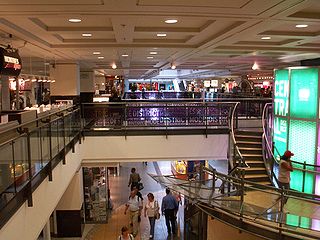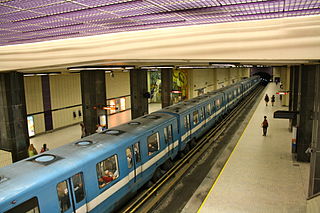
Saint Helen's Island is an island in the Saint Lawrence River, in the territory of the city of Montreal, Quebec, Canada. It forms part of the Hochelaga Archipelago. It is situated immediately offshore from Old Montreal on the southeastern side of the Island of Montreal in southwestern Quebec, and is part of the central borough of Ville-Marie. The Le Moyne Channel separates it from Notre Dame Island. Saint Helen's Island and Notre Dame Island together make up Jean-Drapeau Park.

RÉSO, commonly referred to as the Underground City, is the name applied to a series of interconnected office towers, hotels, shopping centres, residential and commercial complexes, convention halls, universities and performing arts venues that form the heart of Montreal's central business district, colloquially referred to as Downtown Montreal. The name refers to the underground connections between the buildings that compose the network, in addition to the network's complete integration with the city's entirely underground rapid transit system, the Montreal Metro. Moreover, the first iteration of the Underground City was developed out of the open pit at the southern entrance to the Mount Royal Tunnel, where Place Ville Marie and Central Station stand today.

Notre Dame Island is an artificial island in the Saint Lawrence River in Montreal, Quebec, Canada. It is immediately to the east of Saint Helen's Island and west of the Saint Lawrence Seaway and the city of Saint-Lambert on the south shore. Together with Saint Helen's Island, it makes up Parc Jean-Drapeau, which forms part of the Hochelaga Archipelago. To the southeast, the island is connected to the embankment separating the seaway and Lachine Rapids.

The Green Line, also known as Line 1, is one of the four lines of the Montreal Metro in Montreal, Quebec, Canada. The line runs through the commercial section of downtown Montreal underneath Boulevard de Maisonneuve, formerly Rue de Montigny. It runs mainly on a northeast to southwest axis with a connection to the Orange and Yellow Lines at Berri-UQAM, and with the Orange Line west of downtown at Lionel-Groulx.

McGill station is a Montreal Metro station in the borough of Ville-Marie in the downtown core of Montreal, Quebec, Canada. It is operated by the Société de transport de Montréal (STM) and serves the Green Line. The station opened on October 14, 1966, as part of the original network of the Metro.

Berri–UQAM station is a Montreal Metro station in the borough of Ville-Marie, in Montreal, Quebec, Canada. It is operated by the Société de transport de Montréal (STM) and is the system's central station. This station is served by the Green, Orange, and Yellow lines. It is located in the Quartier Latin.

The Orange Line, also known as Line 2, is the longest and first-planned of the four subway lines of the Montreal Metro in Montreal, Quebec, Canada. It formed part of the initial network, and was extended from 1980 to 1986. On April 28, 2007, three new stations in Laval opened making it the second line to leave Montreal Island.

The Blue Line, also known as Line 5, is one of the four lines of the Montreal Metro in Montreal, Quebec, Canada. It was the fourth to be built, notwithstanding its alternate official name of "Line 5", as Line 3 was planned but never built. Unlike the other three routes, the east–west Blue Line does not serve the city's main Metro junction at Berri-UQAM.

Radisson station is a Montreal Metro station in the borough of Mercier–Hochelaga-Maisonneuve in Montreal, Quebec, Canada. It is operated by the Société de transport de Montréal (STM) and serves the Green Line. It is in the district of Saint-Jean-de-Dieu. It opened on June 6, 1976, as part of the extension of the Green Line to Honoré-Beaugrand station.

Lionel-Groulx is a Montreal Metro station in the borough of Le Sud-Ouest in Montreal, Quebec, Canada. It is operated by the Société de transport de Montréal (STM) and is a transfer station between the Green Line and Orange Line, with cross-platform interchange available. It is located in the Saint-Henri area, along Atwater Avenue on that area's eastern border with Little Burgundy. If transfers between lines are included, the station is one of the busiest on the Metro. It first opened in 1978.

Sherbrooke station is a Montreal Metro station in the borough of Le Plateau-Mont-Royal in Montreal, Quebec, Canada. It is operated by the Société de transport de Montréal (STM) and serves the Orange Line. This station, near downtown, opened on October 14, 1966, as part of the original network of the Metro.

Jean-Drapeau station is a Montreal Metro station in Montreal, Quebec, Canada. It is operated by the Société de transport de Montréal (STM) and serves the 4 - Yellow Line. It is situated on the Saint Helen's Island in the Saint Lawrence River.

Longueuil station, officially Longueuil–Université-de-Sherbrooke station, is a Montreal Metro station in Longueuil, Quebec, Canada. It is operated by the Société de transport de Montréal (STM) and is the southern terminus of the Yellow Line. It is connected to a campus of Université de Sherbrooke, as well as the largest bus station in Greater Montreal, Terminus Longueuil.

The Société de transport de Montréal is a public transport agency that operates transit bus and rapid transit services in the urban agglomeration of Montreal, Quebec, Canada. Established in 1861 as the "Montreal City Passenger Railway Company", it has grown to comprise four subway lines with a total of 68 stations, as well as 212 bus routes and 23 night routes. The STM was created in 2002 to replace the Société de transport de la communauté urbaine de Montréal. The STM operates the most heavily used urban mass transit system in Canada, and one of the most heavily used rapid transit systems in North America. As of 2019, the average daily ridership is 2,297,600 passengers: 977,400 by bus, 1,306,500 by rapid transit and 13,700 by paratransit service.

Ville-Marie is the name of a borough (arrondissement) in the centre of Montreal, Quebec. The borough is named after Fort Ville-Marie, the French settlement that would later become Montreal, which was located within the present-day borough. Old Montreal is a National Historic Site of Canada.

Réseau de transport de Longueuil (RTL) is a public transit system in the city of Longueuil, Quebec, Canada, and nearby communities on the South Shore of Montreal. The RTL had an annual ridership of 34,447,686 in 2013.

Saint Denis Street is a major north–south thoroughfare in Montreal, Quebec.

Downtown Montreal is the central business district of Montreal, Quebec, Canada.

The Montreal Metro is a rubber-tired underground rapid transit system serving Greater Montreal, Quebec, Canada. The metro, operated by the Société de transport de Montréal (STM), was inaugurated on October 14, 1966, during the tenure of Mayor Jean Drapeau.
Jean Dumontier was a Canadian-Quebecois architect and artist. He is best known for having designed the Montreal Metro stations Jean-Drapeau and Longueuil-Université-de-Sherbrooke. He was also the first architect of the subway to have himself created the works of art for the stations of his own design, those being the four concrete walls of the dock of the station Jean-Drapeau.



















